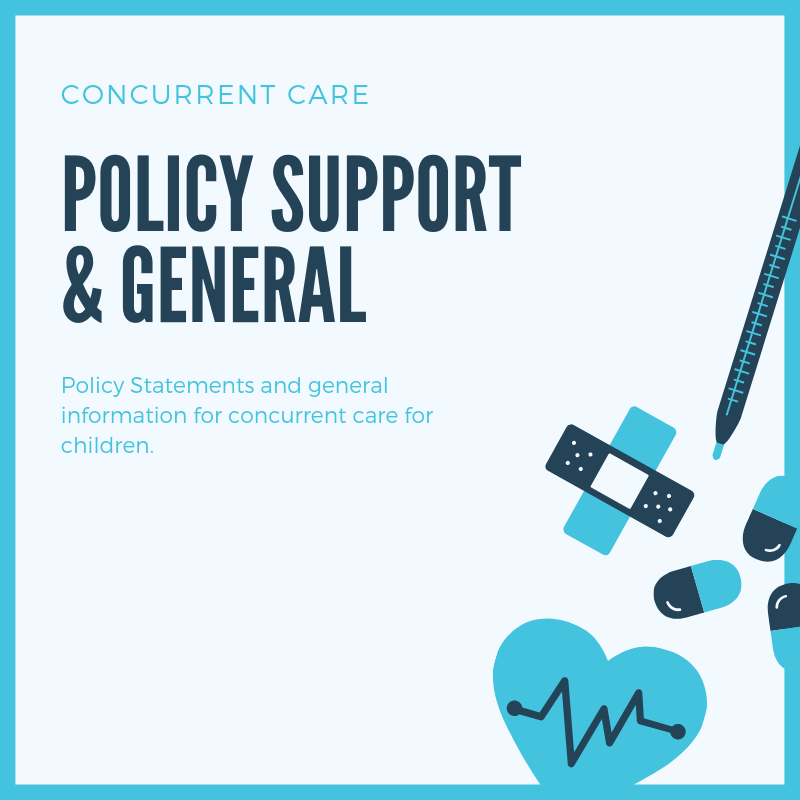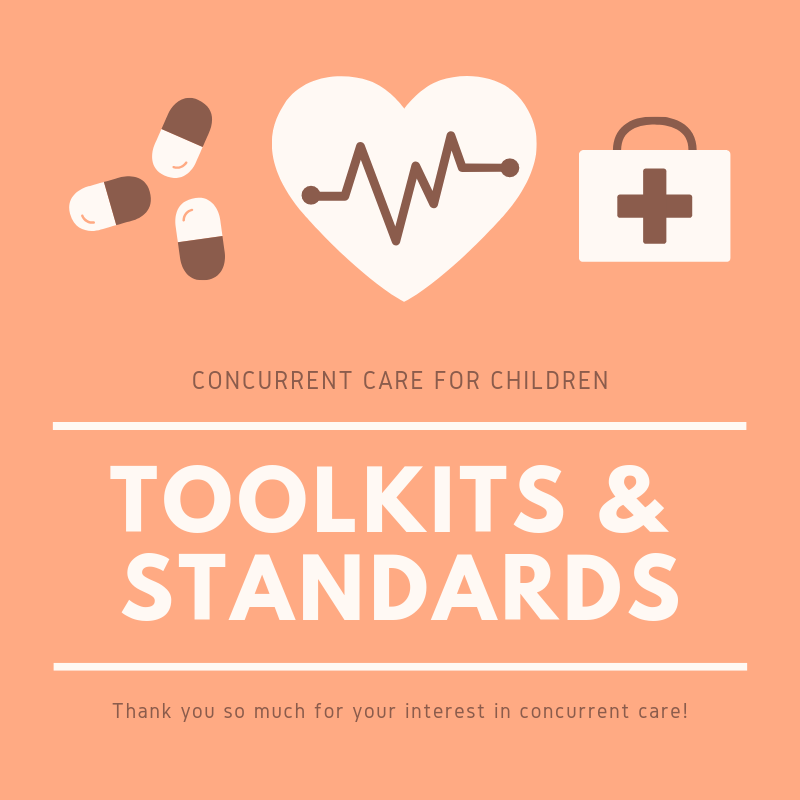Clinical Resources

Policy Statements & General Information
American Academy of Pediatrics in a Policy Statement and frequently asked questions FAQ medical home handout explain a new rule says that state Medicaid programs must allow children who qualify for hospice care to get both curative treatment services and hospice care at the same time — if their family and doctors agree it’s the right choice for them. This part of the ACA is called Concurrent Care for Children (or Section 2302).
CHOP Open-access Medical Education: Palliative Care Course. This seminar series focuses on pediatric palliative care. The lectures are prepared by Children’s Hospital of Philadelphia staff in weeklong modules that are prepared in affiliation with the American Austrian Foundation Open Medical Institute and presented in Salzburg, Austria. The lectures of this seminar are presented in this link.
Concurrent Care from the Bedside to the Community. Learning objectives of this presentation are to define pediatric palliative care and differences from adult palliative care. To define concurrent care benefits and challenges, including barriers to access to care. To discuss two successful care delivery models of primary palliative care from the acute care setting to the community. To identify opportunities for changes in policy to improve access to pediatric palliative care services for the preborn, infants, children, adolescents, and young adults.
NHPCO Continuum Briefing The goal for all who read this briefing is to work together to assure that each state’s most medically fragile children have the quality care they deserve. Individuals, families, professionals and groups can come together, identify champions and develop strategies to overcome barriers to care and continuity of services. The ultimate goal is success in securing the care and resources families desperately need
NHPCO’s End-of-Life Online (E-OL) Courses and Webcasts provide access to on-demand learning. Their E-OL courses and webcasts are specifically designed with cutting-edge technology to provide new insights, innovation, strategy, and information to ensure the delivery of quality hospice and palliative care. E-OL also gives you access to plenary webcasts from NHPCO conferences.

Toolkits & Standards
Concurrent Care for Children CCCR Toolkit 2011
The Patient Protection and Affordable Care Act (PPACA) now requires the state Medicaid program to pay for both curative/ life prolonging treatment and hospice services for children under age 21 who qualify. Specifically, this Toolkit can be used as a guide to: understand the impact of the CCCR on state Medicaid programs; Consider the different Medicaid state plan amendment and waiver options available to states; Review examples of existing comprehensive hospice/palliative care programs for children in states that have implemented such programs; and Learn how to develop a coordinated, collaborative state-wide approach for advocating for children with LL/LTC through a comprehensive array of services.
Center to Advance Palliative Care Pediatric Palliative Care Field Guide
While the goals of pediatric and adult palliative care are the same – to relieve suffering for seriously ill patients and their families – clinical delivery of pediatric palliative care (PPC) differs fundamentally from adult delivery. PPC has experienced notable growth over the past decade – this resource guide compiles current information to support the field’s further advancement. It’s intended as a first stop for practical, non-clinical information on program development, access, quality, awareness, coordination and expansion.
Children’s Hospice International
The four ChiPACC® standards listed below outline basic required components for the development of local Programs of All-Inclusive Care for Children/Adolescents who are diagnosed with life-threatening conditions and the members of their families. The goal of ChiPACC® is to expand access to curative and palliative services beyond the scope of the traditional hospice benefit. The 16 categories of ChiPACC® Practice Guidelines detail the components of a fully developed ChiPACC® program. The Practice Guidelines represent best practices in operationalizing the four ChiPACC program standards.
NHPCO Standards of Practice for Pediatric Palliative Care and Hospice
NHPCO is committed to improving access to hospice and palliative care for children and their families – both nationally and internationally. Review the NHPCO Standards of Practice for Pediatric Palliative Care and Hospice. The National Hospice and Palliative Care Organization’s (NHPCO) Standards of Practice for Hospice Programs are organized within the framework of the Quality Partners Ten Components. NHPCO’s Quality Partners program utilizes the Standards of Practice as its foundation to provide a framework for quality assessment and performance improvement. Learn about the Concurrent Care for Children provision in the Affordable Care Act (ACA) – Briefing and Implementation Toolkit available from NHPCO.
Palliative Care Awareness Social Media Toolkit
This toolkit is designed by the George Washington University Cancer Center to help stakeholders implement evidence based practices when communicating about palliative care. It can also help you plan, implement and evaluate your social media strategy and make the case for why it’s important. Public health professionals, cancer control professionals, cancer centers, coalitions, community-based organizations and other stakeholders can use this toolkit and adapt its messaging for their unique audiences and areas of expertise.
Pediatric Palliative Care Coalition
PPCC Doctor Hospital Care Plan book to help providers coordinate care. The Pediatric Palliative Care Coalition (PPCC) is pleased to provide this Care Plan Book and hopes that it will make your job as a caregiver a little bit easier. We understand how overwhelming and difficult that task can be. Our goal is that this reference guide, to be used by families, caregivers and medical professionals, will become an invaluable source for you and everyone involved in your journey.
PPPC Caring Conversations Toolkit – This guide assists in helping caregivers and families ask certain questions to learn if it is time to start a conversation about hospice or palliative care
Top Ten Tips Palliative Care Clinicians Should Know About Caring for Children Abstract: “Given the limited number of pediatric-specific palliative care programs, palliative care providers of all disciplines may be called on to care for infants, children, and adolescents with serious illness. This article provides a review of the unique components of pediatric palliative care, including key roles within an interdisciplinary team, pediatric developmental considerations, use of medical technology and complexities of symptom management in children with serious illness, hospice utilization, as well as pointers for discussions with families regarding a patient’s quality of life and goals of care.”
Derbyshire Alliance (UK) for End of Life Care Toolkit:
Professionals want to learn more about how to deliver good End of Life Care. The Derbyshire Alliance offers education for professionals working across our county in the UK and allows colleagues to demonstrate their continuing professional development. The Toolkit has been designed collaboratively by professionals who work across Derbyshire (the self-titled ‘Derbyshire Alliance for End of Life Care’) to help teams plan and deliver care for people in their last months, weeks and days of life. Please note under no circumstances should any changes be made to any of the documents without consultation with the membership of the Derbyshire Alliance for End of Life Care
The Guide to Children’s Palliative Care is an essential resource for all those with an interest in planning, commissioning and delivering services and care for babies, children and young people with life-limiting and life-threatening conditions, and their families. Created by Together for Short Lives, this UK charity works both directly and with their members to support children and young people who are expected to have short lives. The fourth edition of the Guide has been written from the standpoint that children’s palliative care is no longer in development but is now a recognized specialty. It has a greater focus on enabling all professionals to better understand the value of a children’s palliative care approach, making the care of life-limiting children everybody’s business.
Clinical Evidence
The health care reform and concurrent curative care for terminally ill children:
A policy analysis (Lindley, 2011)
Factors influencing the implementation of healthcare reform:
An examination of the Concurrent Care for Children provision (Lindley et al., 2014)
The ethics of concurrent care for children:
A social justice perspective (Mooney-Doyle, et al., 2018)
Educational Resources
Learners will find general education specific to the pediatric population focused on end of life.
- Nursing ELNEC Course (pediatric)
- HPCC Nurse Certification (pediatric)
- Harvard PCEP Course (pediatric)
Resources available to support education on Pediatric Concurrent Care. Topics under development include “Introduction to Concurrent Care in Pediatric End of Life.”
Concurrent Care for Children (ACA Section 2302)
Pediatric End of Life Care
Familiarize yourself with the federal regulation that mandates the concurrent care intervention.
State Implementation
The Centers for Medicare & Medicaid (CMS) issued guidance to all states to implement ACA Section 2302.
Research Study
An analysis of administrative claims is being conducted to build evidence on concurrent care.
Stay Informed
Contact the PedEOL Care research team to find out more about concurrent care on the website and social media.




